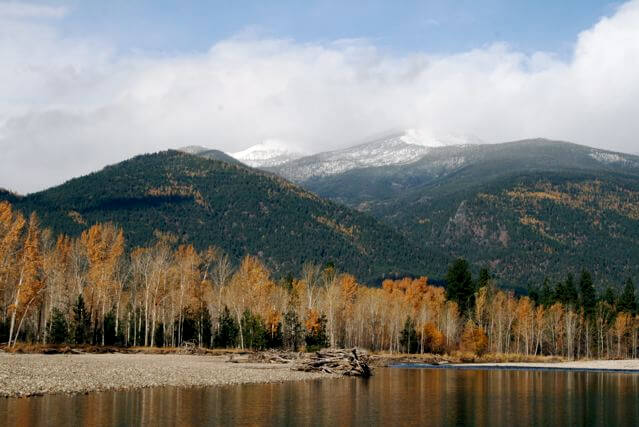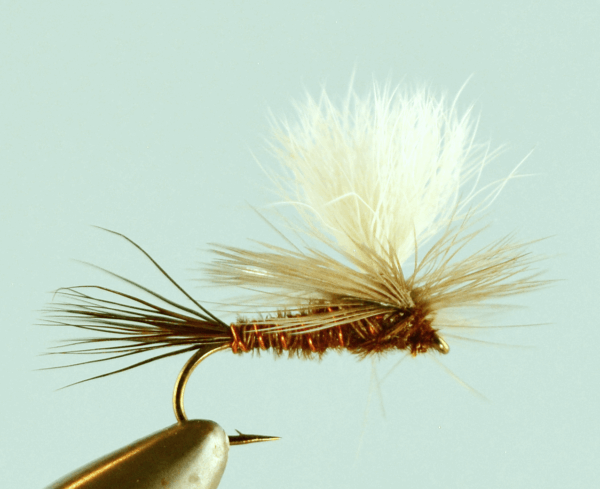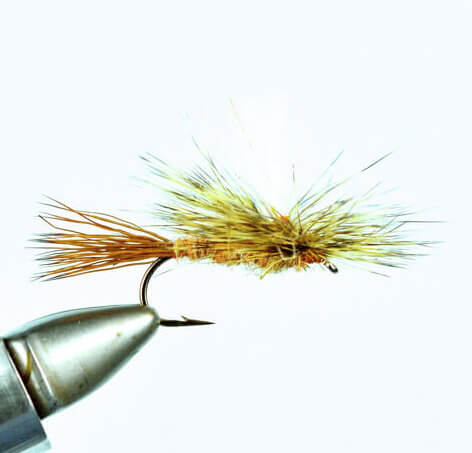September fly fishing in Missoula is arguably the best time of year. The water is low, reaching prime temps with longer, cooler nights with the most comfortable wading of the year. The bugs are diverse in size, ranging from size 6 hoppers to size 22 Blue Winged Olives. Subsurface, the nymphing is excellent with so much insect activity, while the streamer fishing comes on as September progresses. It doesn’t matter what type of fly fishing you’re looking for, if you’re in Missoula in September, you’re going to find it. Lets take a look at some of the best flies for September fly fishing in Montana.
Hoppers
September starts with the same flies as you’ve been using since August 10th. The grasshoppers have established, with fish on the prowl looking for a big, easy meal. Missoula hopper fishing starts in late July and depending on weather, may last into November! That’s over 3 months of fish seeing naturals, and their imitations. September is a good time to do a little experimenting with different hopper variations. We carry Pav’s Hopper in 5 different colors, and variations on the Morrish Hopper in 4 different colors. We have gray hoppers, blue hoppers and many pink ones. Why do they work? No idea, but they do. We watch Missoula’s best fly fishing guides shop every morning, and in September they will be looking for full fly bins. The theory is no one is buying them, so the fish haven’t seen too many. Think about expanding your hopper game in September to show the trout
something new and different.
Tricos
The same can be said for Tricos. In early September, you can almost set your watch by the trico hatch. The fish have been looking at naturals for almost a month, and they can get a bit snotty at this time of year. Think about some Trout Hunter tippet in 5.5X. Trout Hunter tippet is much softer than Rio, and allows your bug to float more naturally. The half sizes of tippet provide more stealth without sacrificing as much strength. Move to trico cripples and emergers, like the Sprout or the Quigley Cluster Midge. Ron’s Trico Spinner will produce consistently as well, though by this time of year he is way tired of tying them! Be ready to drop down to a size 20 as well, so make sure you’ve got your readers when you hit the water.
Blue WInged Olives
We’re all waiting for the magic moment in September- the first real rains of fall. If we’re lucky, the rain comes in about September 10th, and the entire complexion of fly fishing in Missoula changes. The weather change brings cooler temps and some clouds. The tricos trade out for Blue Winged Olives. Same size- different color. The week after the rains will prove to any angler that fish can see color! If you fish a trico through a BWO hatch or vice versa, you’re not going to be anywhere near as successful as you could be. Look for the classic figure 8 of a trico spinner cloud above the water, or get your nose close to the water and check what’s floating by. It makes a big difference!
As the BWO’s start, the basic patterns will work. A simple Parachute BWO or Comparadun will take fish consistently at the start of the hatch. But as the BWO’s extend through September, growing in numbers, the fish get a lot more selective. The Last Chance Cripple or Quigley Split Flag Cripple will start to be more effective for fussy trout. Again, shift down with your tippet size to give your fly the best chance at a drag free drift. Watch rise forms very carefully when BWO’s are on the water. Many fish focus on emerging nymphs, and while you’ll see concentric “rise” rings, it’s the fish’s back that breaks the surface, not the mouth. Drop an unweighted Size 18 Pheasant Tail about 4 inches off the back of your dry and watch your catch rate skyrocket.
Mahoganies
In the middle of the month, the Mahoganies start to make their annual appearance. This size 14 mayfly is tough to miss on a Fall afternoon, and provides a steady hatch for the next 3 weeks. The Parachute Pheasant Tail, Purple Haze or Brindle Chute all in size 14-16 are excellent choices at this time, with the Brindle Chute out performing most other flies when the Mahoganies are on, especially on the Bitterroot River where it was invented. Again, as the hatch progresses, start to get a bit more technical with your flies. Bring some Last Chance Cripples or Sparkle Duns when the fish are ignoring your standard fare.
October Caddis
At the end of the month, you can start looking for the October caddis to appear. If you think you can’t miss the Mahoganies, you REALLY can’t miss the October Caddis. This size 8-10 orange caddis is a favorite of fish on the Blackfoot River, Bitterroot River, Rock Creek and the Clark Fork River. If you see one, tie one on. The fish are looking for them and will eat even when the naturals aren’t strong. Both the Orange Elk Hair Caddis and the Orange Goddard Caddis will float a small dropper as well, so make sure to utilize that option as well. The Birds of Prey October Caddis Pupa is deadly subsurface, and if you’re not getting the action you’re looking for on top, get down with the pupa to bring your fish count up.
Nymphs
With all the hatches across Missoula’s rivers, the nymphing can be off the hook! With lower water levels the droppers are shorter and easier to control, especially on the Bitterroot River and Rock Creek. Don’t be afraid to go small. Early in September, the SR Bullet Black in a size 18 is a great trico nymph. When the weather changes the rivers to BWO’s, switch to an SR Bullet Olive and keep raking in the fish. A Pheasant Tail Jig will outperform most anything for the Mahogany nymph, and don’t forget the October Caddis Pupa. It should be said again, if fish aren’t eating on the surface, they’re eating underneath- dry flies get the ink, nymphs get the fish. Especially at the end of the month, when the cold weather tells the fish winter is coming, and they need to eat.
Streamers
The same weather that moves trout to nymph hard also moves fish to eat streamers. When the days start to get cooler and shorter, a great way to start the day is working a small to midsize streamer around the likely areas. If your streamer choice is comfortable to cast on a 5-6 weight, it’s proabably the correct size. This is conventional wisdom, but there are exceptions. In the big water of the lower Clark Fork River and the lower Blackfoot River (which is now bereft of tubers due to the cold) a big streamer run deep will still work its magic. If you’re a streamer-maniac, the last week of September can be prime time, moving bigger fish looking to take in a few calories before the real weather gets here. Pick your spots to run the Mongrel Meat or Sex Dungeons, or go smaller with a Baby Gonga or Dirty Hippie.
Final Thoughts
Whatever you’re looking for when you head to the water, September fly fishing in Missoula has the answer. Whether you want technical dry fly fishing, prospecting with dries, focused Euronymphing, Hopper/dropper or streamer action, somewhere on Missoula’s diverse rivers you’re going to find it. The weather is relatively mild, the wading is easy, the rivers are at good flows and better temps, and you can expect good days on the water. If you live here, carve out some time to fish during some of the year’s best fly fishing in Missoula. If you’re traveling from out of town, get ready to see some of the best fly fishing Missoula has to offer. We’ll see you in the shop, or hear from you online!
Missoula Montana Guided Fly Fishing Trip
Come enjoy a day on the river with Missoula’s best fly fishing guides. We float the Bitterroot River, Blackfoot River and the Clark Fork River. All gear, lunch and transportation provided.
















